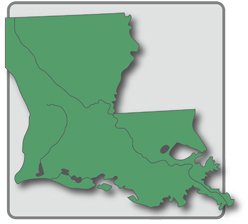EPA Research in Louisiana

EPA researchers are working hard to protect communities across the nation. Learn about some of the work EPA researchers are doing in Louisiana.
- Empowering Communities with the EPA Flooded Homes Cleanup Guidance Tool
- Collecting Emissions from Natural Gas Boilers
- EPA’s Reactive Fish Sculpture Turns Water Quality Data into Art
- Village Blue Lake Pontchartrain Offers New Orleanians Insights into Local Water Quality
- Deadly Bacteria Outbreak
- Contaminated Groundwater from Former Battery Demolition Site
- Ecosystem Services Assessment of the Ouachita River Ecosystem
For more EPA work, see EPA in Louisiana.
Empowering Communities with the EPA Flooded Homes Cleanup Guidance Tool
Flooding is one of the most common types of natural disasters impacting people in the United States. A flooded home can result in various health hazards and it can weeks for people to be able to re-enter their homes. EPA scientists developed a website that provides tips and informational videos for people impacted by flooding to prepare for re-entering their home and beginning cleanup. To develop the website, EPA scientists worked with the the Louisiana State University AgCenter, the St. Bernard Project (a nonprofit disaster relief organization in Louisiana), and other institutions to conduct interactive community outreach. Read Flowing with Feedback: Empowering Communities with the EPA Flooded Homes Cleanup Guidance Tool.
Collecting Emissions from Natural Gas Boilers
One way EPA collaborates with partners is through Cooperative Research and Development Agreements (CRADAs). These collaborations can lead to improved research outcomes, and often, the creation of new intellectual property. EPA researchers signed a CRADA with Dow Chemical Company to measure stack emissions using unmanned aircraft systems. EPA and Dow gathered air samples downwind of natural gas boiler stacks at Dow facilities in Midland, Missouri and New Orleans, Louisiana. Read EPA works with Dow Chemical Company to Collect Emissions from Natural Gas Boilers.
EPA’s Reactive Fish Sculpture Turns Water Quality Data into Art
EPA’s Village Blue Lake Pontchartrain project is showcasing science through art in New Orleans. EPA scientists engineered Gil, a reactive fish sculpture, using electronics and LED lights to show changes in water quality data from two different USGS sensor sites – one on Lake Pontchartrain and the other on the Mississippi River in Baton Rouge, Louisiana. Read EPA’s Reactive Fish Sculpture Turns Water Quality Data into Art.
Village Blue Lake Pontchartrain Offers New Orleanians Insights into Local Water Quality
Water quality monitoring can be a powerful tool to help keep local water bodies healthy. In 2021, EPA launched Village Blue Lake Pontchartrain, a water quality monitoring project in New Orleans that helps the community learn more about their local water quality and its greater connection to the Mississippi River. Read Village Blue Lake Pontchartrain Offers New Orleanians Insights into Local Water Quality.
A Year in Review: Progress on the Research Goal of the Federal Lead Action Plan
EPA researchers have been working on various aspects of lead research to support the Federal Action Plan to Reduce Childhood Lead Exposures and Associated Health Impacts. As part of this work, in May 2019, EPA worked with several South-Central states (Texas, Louisiana, Arkansas, New Mexico and Oklahoma) and the Association of State Drinking Water Administrators, to hold a workshop to provide information and training relevant to small drinking water systems related to lead. Read A Year in Review: Progress on the Research Goal of the Federal Lead Action Plan.
Deadly Bacteria Outbreak
In 2015, the deadly bacteria, Burkholderia pseudomallei, was released from a high-security laboratory at Tulane University’s Primate Research Center. EPA researchers in the Office of Research and Development worked with the university and the State of Louisiana on sampling and analysis and proper management of potentially contaminated wastewater. Read more about this work and learn about EPA's wastewater contamination research.
Contaminated Groundwater from Former Battery Demolition Site
A former battery demolition site in Ponchatoula, Louisiana resulted in significant contamination of groundwater. The site borders a large creek that runs adjacent to a residential neighborhood. To mitigate impacts to the creek, a permeable reactive barrier (PRB) was installed to intercept the impacted groundwater and both neutralize the sulfuric acid and remove the heavy metals prior to entry of the groundwater into the creek. EPA Office of Research and Development has been working with the Louisiana Department of Environmental Quality and EPA Region 6 to evaluate the long-term performance of the PRB in preventing discharge of contaminants into the creek.
Ecosystem Services Assessment of the Ouachita River Ecosystem
While the Ouachita River offers economic, infrastructure and natural benefits to surrounding communities, the region and its cities, Ouachita Parish includes some of the most flood-affected areas in Louisiana. EPA Office of Research and Development, in partnership with the EPA Region 6, convened a series of workshops in 2018 and 2019 for 35 participants representing federal agencies, community stakeholder groups, state and local government agencies, and universities. Together, these stakeholders prioritized flood mitigation projects along the Ouachita River that were expected to have the greatest benefit to human well-being.
